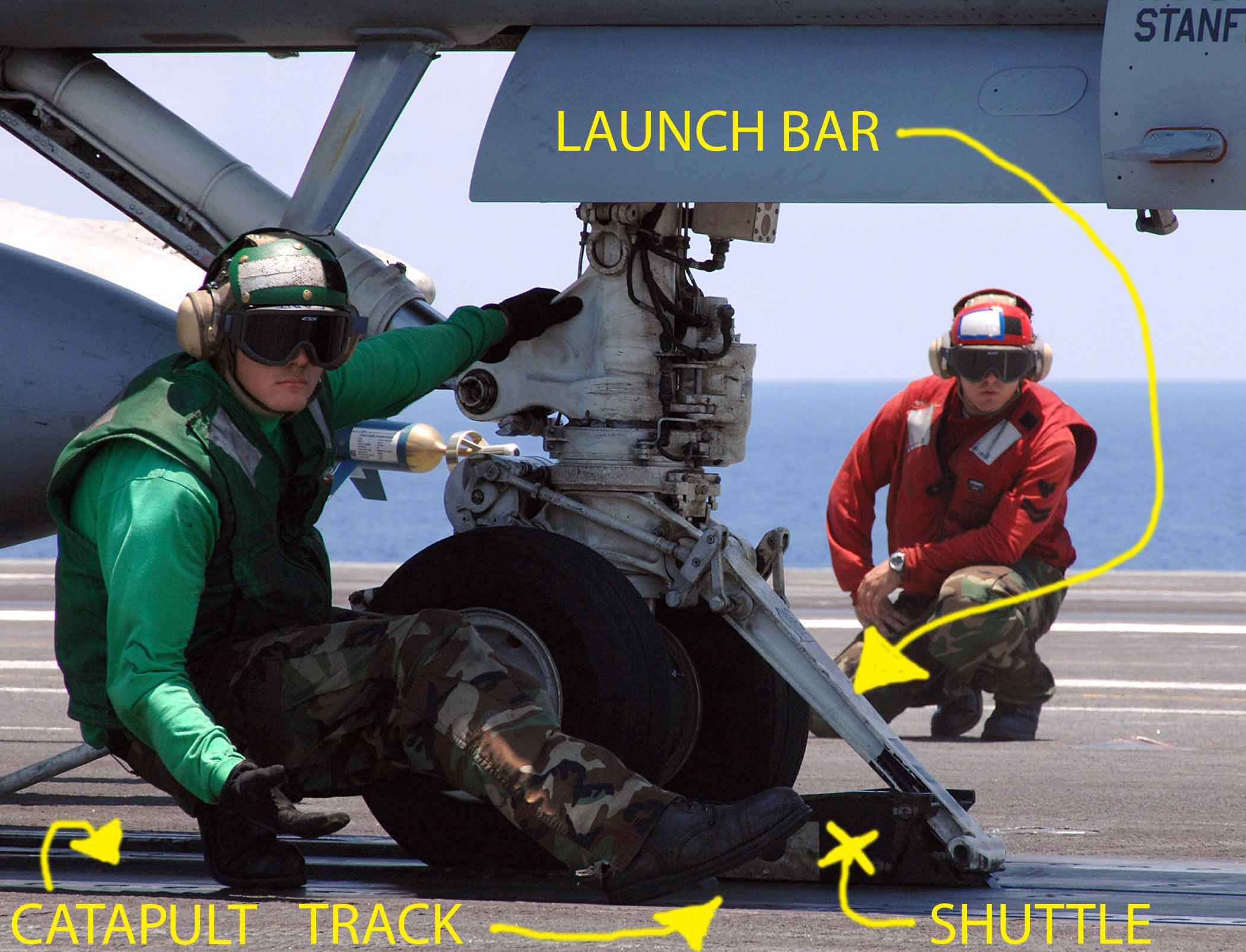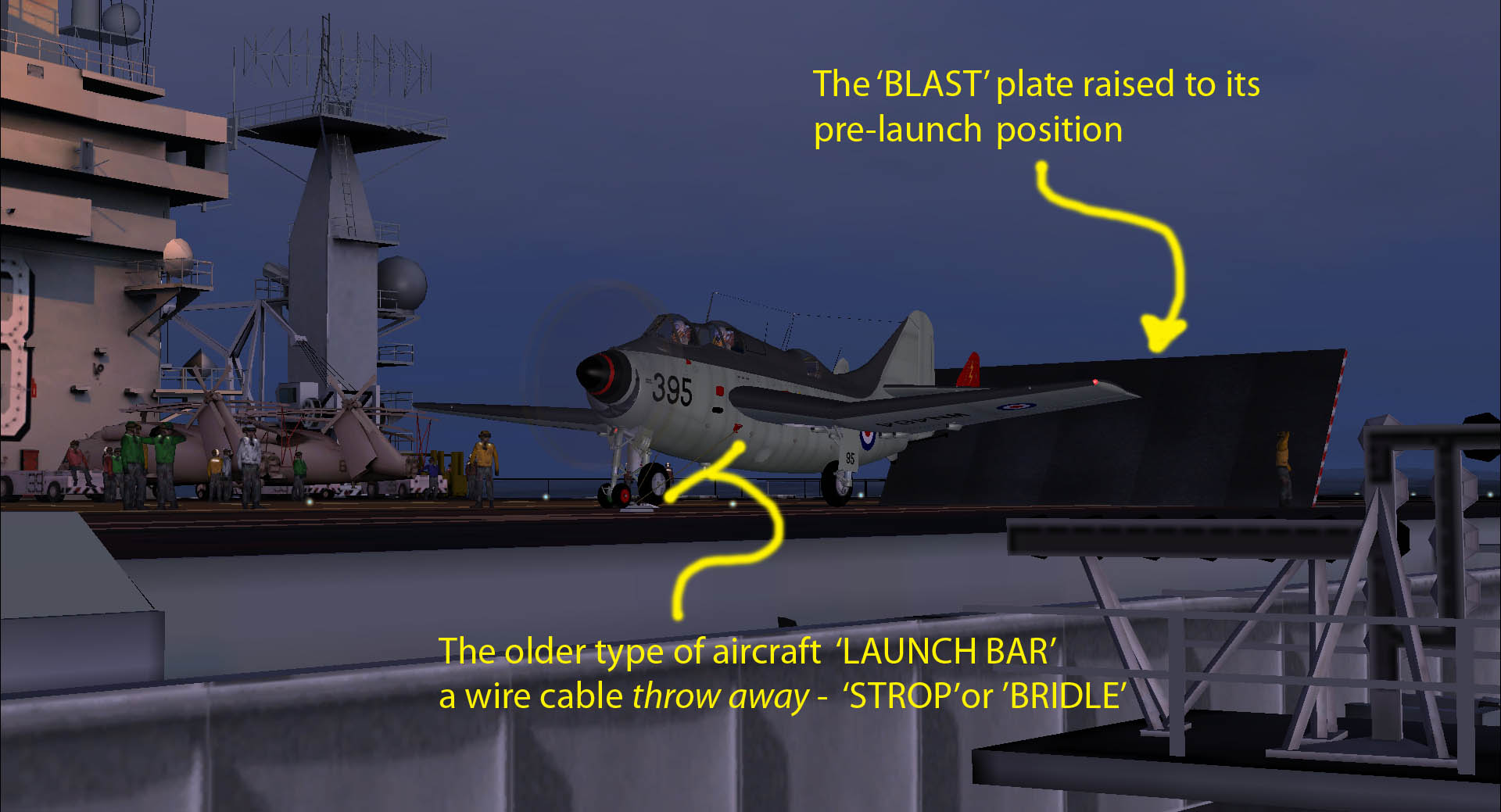Catapult Launching
IMPORTANT - A CAUSE OF MUCH FRUSTRATION
IF YOU FOLLOW THESE INSTRUCTIONS AND YOU DO NOT GET A DEFINITE CATAPULT LAUNCH THEN YOUR KEYBOARD MAPPING HAS PROLLY BEEN OVERRIDDEN BY YOUR YOKE OR STICK MAPPING FILE.
YOU CAN CHECK VISUALLY BY LOADING THE T-45 THEN TRY THE KEYBOARD COMMAND SEQUENCE <SHIFT> + <U> (LOWER LAUNCH BAR).
LOOK OUTSIDE AT THE NOSE WHEEL - IF A WHITE BAR HAS NOT LOWERED FROM JUST ABOVE THE NOSE WHEEL, THEN GO INSIDE THE COCKPIT AND CLICK THE 'LOWER LAUNCH BAR SWITCH' (TOGGLE) - LEFT SIDE BELOW THE LARGE YELLOW 'EMERGENCY LANDING GEAR SWITCH'. IT IS A SMALL WHITE SWITCH EASY TO MISS AT FIRST LOOK. CHECK OUTSIDE AGAIN.
IF THE WHITE BAR HAS NOW LOWERED THEN KEYBOARD MAPPING IS YOUR PROBLEM.
TWO WAYS OF DEALING WITH IT.
IF YOU HAVE A CH YOKE THEN YOU CAN HAVE A COPY OF MY YOKE CONFIG FILE FIXED FOR THIS PROBLEM OR
GO TO SETTINGS, CONTROLS, BUTTON ASSIGNMENTS, LOOK DOWN THE LIST FOR THESE THREE ITEMS AND CHANGE THE ASSIGNMENTS FROM NOTHING TO THOSE SHOWN.
'Takeoff assist (arm/dissarm)' SELECT <NEW ASSIGNMENT>
ASSIGN SEQUENCE <SHIFT> + <I>
'Launch bar (extend/retract)' SELECT <NEW ASSIGNMENT>
ASSIGN SEQUENCE <SHIFT> + <U>
ASSIGN SEQUENCE <SHIFT> + <SPACEBAR>
(That means put your cursor in the box the do the key sequence, i.e press and hold the SHIFT key then tap the spacebar and the key presses will appear in the box.)
Now if you do not close FSX properly and reopen it you may have to repeat that every time you fly. So just check that your yoke configuration or mapping is not being constantly overwritten once you have changed an assignment yourself, by re-checking it is still there after a re-start.
Moving on... There are 2, 3 or 4 Catapults on each carrier.
Two at the front, (the Bow), one or two near the middle. (Amidships).
The catapult can be identified by a long narrow darker track than the normal deck, with a small rectangle at the starting end of the track. The other end stops near the edge of the deck.
Aircraft always launch from the ‘rectangle’ end of the catapult to outboard of course.
NOW THE IMPORTANT BIT IF YOU WANT TO MAKE THEM WORK
The SHUTTLE (no nothing to do with the space shuttle)
Look at the centre of the track, near the rectangle, you will see the catapult connection point, the towing point of the catapult, the catapult ‘SHUTTLE' . So called because it shuttles or travells up and down the catapult track at each launch. Like a tiny lighter colour triangle block standing up from the centre of the catapult track. This is the bit on the carrier that the 'LAUNCH BAR' of the aircraft engages with to make the launch.
You have to move your aircraft nose wheel to within a meter (3 feet) of this 'SHUTTLE' to be able to make a catapult launch OR IT WILL NOT WORK.

Launch crew in action. Colourful jerseys but they all have different colours for different jobs.
This can take a while to learn how to do. Try using an outside view to watch your nose wheel as you get as close as you can to the ‘SHUTTLE’.
Use <SHIFT> + <P> Push back (toggle) To start and stop reverse
NOTE - You cannot steer while the the PUSH BACK - reverse is working
When you are satisfied that you are close enough to the ‘SHUTTLE’ press
lower/retract (toggle)
Have a look - see if it is down. If you have
an older aircraft, like the GANNET they used a 'STROP' so you should see this instead of a 'LAUNCH BAR' engaging with the 'SHUTTLE' . These 'STROPS' (USA BRIDAL'), were 'thrown away' each time the catapult fired.
NOTE - You cannot steer while the 'LAUNCH BAR' is lowered
NOTE - You cannot 'RAISE LANDING GEAR' while the 'LAUNCH BAR'
is lowered.
<SHIFT> + <I> ARM CATAPULT
If the aircraft is within one meter of the ‘SHUTTLE’, the aircraft will ‘jump’ to the exact correct position.
The * ‘BLAST PLATE' rises up from the deck behind the aircraft
And if you are on the Nimitz you will also see this:-
Deck Officer will move to your cockpit vision zone. He kneels on one knee, and holds his arm outstretched pointing you off the deck ‘You are clear to launch' – salute me and I will fire you off the deck’. (haha no need to really salute him just carry on as below).
FULLPOWER
Do not hit the launch straight after applying full power, remember
'spin up lag' and the need to have full thrust available when the catapult fires 9 tonnes of metal in the air. Look at your engine gauges,
sure you have firm steady 100% from power plants before launch.
The flaps should be set ‘greatest lift’ normally first notch 10% The aircraft should be ‘clean’ no spoilers or air brakes deployed. Hold some up elevator, be ready to change this rapidly so as to maintain your best climb out speed from the aircraft's ‘Pilots Notes’ for you present configuration and loading.
Having done a good few short take off's myself, if this is anything like them, then at this point holding on brakes with full power the aircraft is shuddering just wanting to get into the air.
NOTE
Do NOT retract FLAPS below 300 feet and then only in stages. A stage of flap in can loose you a 100 feet or more in a few seconds.
Do NOT NOT NOT retract any HIGH LIFT DEVICE like leading edge SLATS below the safe altitude as quoted in the PILOTS NOTES. Retracting high lift devices at high angles of attack can seriously ruin your whole day without enough warning to do much about it but hope you have enough altitude to recover. Doubtful considering when you normally deploy them.
<SHIFT> + <SPACEBAR> Launches you off the deck
* 'BLAST PLATES' are small sections of the deck that are hinged and hydraulically raised at right angles to the deck during a launch to protect people and aircraft and equipment from jet and prop blast or 'backwash'.

What do all those hand signals mean that the flight deck crew keep giving me?
Well a visit here should help you work that one out:-
http://navysite.de/cvn/catcom.htm
Jersey Colours (not concise yet)
Purple Re-fuelling
Blue Aircraft movers
Aircraft Lift Operators
Aircraft tow DriversGreen Catapult and arresting Crews
Maintenance
Yellow Catapult Officer
Aircraft Directors
Red Arming
Brown
White Safety Medical